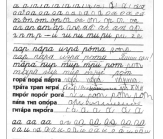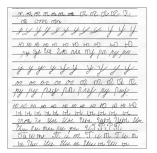At present one can notice a great increase in the number of children with mental disorder. Experts assert that traditional, generally accepted psychological-pedagogical methods of correction and development in many cases are not effective.
At present kinesiology methods seem to be one of the most effective ways of higher psychic functions development of schoolchildren. Modern kinesiology methods are aimed at activization of different sections of big hemispheres cortex that gives a chance to develop man’s abilities or corrigate different problems of psyche.
In the program «Brain Gym» P. Dennison adapted the research results of K. Ameden, L. Zhakee, S. Herr, G. Getman, R. Tyler, B. Gibbs on children with the label «unable to learn» and worked out his system of quick, simple, specific according to its aim movements which have an effective, corrective and developing significance. Since the moment of its foundation in 1987 the research projects of the Edu-Kinesiology Organization using «Brain Gym» have spread all over the world and have given significant results.
P. Dennison’s «Brain Gym» exercises and those of the «Program of Forming Neuro-Psychological Space of Junior Schoolchildren» worked out by A.L. Sirotyuk and N.S. Sirotyuk could be divided into four groups: midline (reciprocal), lengthening, energy and posture.
Midline (reciprocal) movements promote the development of the interaction between the two hemispheres, the removal of synkinesis and clampdown of muscles. It’s interesting to note that a man can think while sitting motionless. Though to consolidate a thought a man needs some movement. I.P. Pavlov believed that any thought was finished by movement. R. Sperri offered to accept the conception of brain activities as a means of bringing some additional meaning to motor behavior. It’s because of this that for many people it’s easy to think while moving or doing some movements for instance while swinging a leg or walking or tapping with a pencil on the table or chewing some crunching food. Some people use their hand, putting down their thoughts on the paper. Some others use the movement of their tongue, lips, larynx and vocal chords saying their thoughts aloud. As a result of movement during the process of thinking some neuron nets are formed that give a chance to consolidate new knowledge. Besides in this process there takes place the secretion of acetylcholine through the synapses of activated neurons, that promotes the growth of dendrites and the development of nervous system. It is well known that those children who missed a very important stage in their development, that is crawling, experience difficulties in their studies. The fact is that during the process of crawling children use cross movements of their arms, legs and eyes that stir to activity the development of callous body. Slow cross movements favour the activity of vestibular apparatus and frontal brain lobes.
Cross movements also develop co-ordination of both eyes, ears, arms and legs movement and balance the work of central body muscles. During this process we can also notice an intensive development of callous that coordinates the simultaneous work of both hemispheres.
Lengthening exercises normalize hypertone and hypotone of muscles. Any deviation from optimum tone is both a cause and an effect of the changes that appeared in psychical and moving activity of a child and shows a negative effect on the general course of his development. Hypotone is usually connected with the decrease of psychical and moving activity of a child, with a slow switching of nervous process, emotional languor, poor motivation and weak volitional efforts. Hypertone is shown in moving anxiety, emotional lability, sleep disturbance. Such children usually lag behind in forming attention at will, as well as differential moving and psychical reactions, that give a peculiar irregularity to psycho-motive development and can provoke the appearance of ADHD («Attention Deficit Hyperactive Disorder») syndrome.
Lengthening exercises take away negative influence of defensive reflexes in a stress situation (a reflex of peripheral eyesight, a defensive reflex of Achilles tendon) after which the brain is ready to transfer information from back areas of the brain to the front ones, from the right hemisphere to the left one. A brain blocked by stress is not ready to the process of teaching.
Energy and posture exercises provide with the necessary speed and intensity of nervous processes among the groups of the brain nervous cells. The exercises are based on the knowledge of reflex and «psychical» zones of the body functioning. Besides they contribute to deepening of positive attitude to the process of teaching, stabilize and rhythmirize organism nervous processes, influence the emotional-lymbic system of the brain, such as breathing, eye-moving, visualizing exercises and massages.
Breathing exercises improve organism rhythm, develop self-control and person’s readiness to do anything at will. Rhythm disturbance (electrical activity of the brain, breathing, palpitation or tachycardia, intestines peristalsis, pulsation of vessels, etc.) is sure to lead to some disturbance of a child’s psychical development. The ability to control breathing at person’s will develops self-control of one’s behavior.
Breathing exercises are especially effective for the children suffering from ADHD syndrome. Different stages of breathing could be combined with various exercises for eyes and the tongue. It is also very effective to combine breathing exercises with visual and sensory systems («inflating» colour balls in one’s stomach, «inhaling» (breathing in) sun light and «golden» energy, etc.). Besides such exercises as jumping on trampoline, riding, holding one’s breath during diving also ensure good rhythm of one’s organism. It is well known that holding one’s breath and «weightlessness» (swing, swimming, jumping on trampoline) stir up the work of brain stem structures, that in their turn, stimulate further development of a child.
Eye-motor exercises give an opportunity to broaden field of vision and to improve perception. Single-directed and different-directed movements of eyes and tongue develop better interaction between the brain hemispheres and improve organism vital energy. In three-dimensional medium eyes are in constant movement, collect sensor information and build complex schemes of images necessary for teaching. Three-dimensional visual perception in a necessary condition of successful teaching. Unfortunately, in education activity it is two-dimensional perception that is used most often (a book, a table, an exercise-book, a computer, etc.), and it brings down the quality of teaching.
Exercises based on the movements of eyes, tongue and jaw stimulate the work of basal ganglion of limbic system, including specialized area – black substance, that connects basal ganglion with frontal brain lobe, that control thinking, speech and behavior.
Visualization (or vision) – is a process when a person has a non-existent object or event in his imagination (visual, auditory, sign, tactual, olfactory and other images). Visualization takes place in both hemispheres of the brain, that contributes to the effective development of callous body.
Correction work should include different kinds of massages. Massage of fingers and ears is especially effective. Experts count 148 points on the surface of the ear corresponding to different parts of the body. Touching a baby as soon as he was born stimulates the growth of sensitive nervous ends on the body, that involves him into movement, space orientation and visual perception. If nervous ends remain passive and don’t stir to activity it leads to the delay of the development of muscles, to the decrease of information, perception, defects in the development of emotional sphere and difficulties in the process of teaching.
Jin Airs worked out a program to correct children’s disorders that appear in the process of teaching by means of stirring up tactile receptors of sensor system to activity. The American doctor Glen Doman achieved impressive results in the work with children who had considerable inborn brain traumas. His methods are simple and effective and have a great deal of common traits with those of Sh.A. Amonashvilli and V.A. Sukhomlinski. To develop higher psychic functions of Tver junior schoolchildren we use «Brain Gym» program of Paul E. Dennison (USA) and the «Program of forming neuro-psychological space for junior schoolchildren» of A. Sirotyuk and N. Sirotyuk. The following educators are involved in the research program: Dr. Joan Spalding (USA), A.L. Sirotyuk, N.S. Sirotyuk, L.A. Makhnovets, Tver primary school teachers: V.A. Sotnikova, N.V. Makarova, L.P. Poyarkova, N.N. Tsvetkova, I.V. Morosova, O.V. Kaleman (music teacher), L.E. Krasavtseva (psychologist), several groups of junior schoolchildren and their parents. Every day the researchers do 10-15 minutes sets of exercises (midline movements, lengthening activities, energy and posture exercises), use water and individual cards with «X».
Primary school teachers point out that in the course of training pupils learned to do cross-lateral movements though before those exercises they could only do homo-lateral (one-side) movements. Besides we could notice that pupils became more active and attentive and better involved into teaching process, their handwriting improved, they began to read faster, better memorize verses and poems as well as the whole process of their thinking became faster and better expressed. Pupils began to learn the teaching material much better and could think logically. O. Kaleman (music teacher) noticed that the children’s voices became stronger, they had a better ear for music and their creative thinking during music lessons became better developed. The pupils also learned to verbalize their feelings and emotions after listening to music much better.
The cuts of neuro-psychological analysis of the pupils’ psychic sphere have been made on the basis of qualitative-quantitative analysis of the investigation data according to the express methods of L.S. Tsvetkova. As a result of improving kinesiological work that was done according to Brain Gym program and the program of neuro-psychological space formation in junior pupils one could see significant positive changes in moving sphere, memory, gnawsis; vocal functions and thinking, which provide proper mastering of reading, writing and counting. It should be noted that the children with a low level of higher psychic functions development have a stronger positive dynamics than those with a high one. It is possible to illustrate the effectiveness of «Brain Gym» and «The Program of forming neuro-psychological space of junior schoolchildren» by giving an example of Vanya’s progress in handwriting, that we could notice within a month of such exercises (Vanya has a low level of higher psychic functions).
Vanya’s handwriting before the exercises:
And after a month of exercises:
So the influence on sensor-motor level with due regard for general conformity of ontogenesis provides activization in the development of all higher psychic functions. As senso-motor level is a basal one for further development of psychic sphere it seems logical at the beginning of the developing process to give preference to motive methods.
To promote the development of junior pupils we recommend to use one of kinesiological sets of exercises (those of P. Dennison, A.L. Sirotyuk, N.S. Sirotyuk). While doing these exercises it is necessary for pupils to use water.
The recommended set of exercises:
-
Cross Crawl exercise. Water before Cross Crawling help prepare the body and brain to respond. Opposite arm and leg move simultaneously. At first pupils touch their hands to their opposite knees in front of them and then to their heels behind their back. It is also possible to accompany those cross-crawling movements by jumping on the spot.
-
Lengthening activity. General strain of the body. Slackness: up and down (straining of the upper part of the body, then that of the lower one), left-side and right-side (straining of the right and then that of the left part of the body), cross strain and slackness of the left hand and right foot and then of the right hand and left foot.
-
Breathing exercise (2 minutes). When breathing out the children are told to draw in their belly as strong as they can. While breathing in the children are told to weaken their belly’s muscles then start breathing in while inflating «a ball» in the belly, for example of red colour (it’s possible to imagine balls of different colour). Then children have a pause (holding their breath) – 2 seconds. Then exhalation follows.
-
Eye-moving exercises. The pupil’s head is fixed. He is looking straight in front of him. Then he starts moving eyes in four directions (up, down, to the right, to the left) then to the centre. Those movings are done slowly (from 3 to 7 seconds) while fixing extreme positions. The teacher who watches the pupil should pay special attention to the area where the pupil’s look “slides off» trying to hold it and make it more stable.
-
Energy exercise (massage of cochlea). Pupils rub the lobes of their ears, then the whole ear. They finish this exercise rubbing their ears with their hands.
-
Finger exercises.
«A Ring». Pupils touch upon their fingers in turn and as fast as they can, forming a ring with the help of a thumb and then in succession with a forefinger, middle finger and etc. This exercise is done both in direct order (beginning with a forefinger and then to the little one) and then in the other way (from a little finger to a forefinger). At first the exercise is done by each hand separately, then by both hands together. Look at the picture.

«A fist – an edge of the hand – a palm». The pupil is shown three positions of the hand on the floor, which change each other in succession. A palm on the plane of the floor, then a palm doubled into a fist, then the edge of the palm on the floor plane, and then the straightened palm on the floor. The pupil does his exercises together with the instructor, then he repeats the motor program himself 8-10 times from memory. This exercise is done first by the right hand, then by the left one, then by both hands together.
When pupils are in difficulties to do the exercises, the instructor offers those pupils to help themselves with the commands (e.g. «fist – edge – palm») which they should say aloud or to themselves.
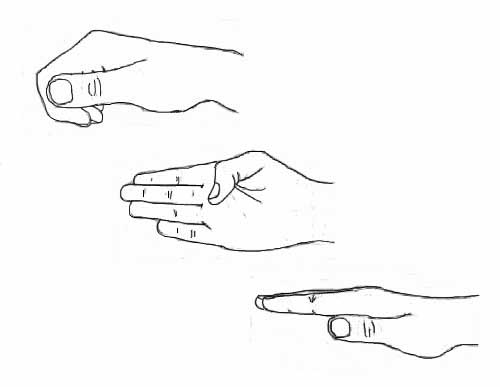
«Lezghinka». The pupil clenches his fist, puts a big finger aside and turns the fingers of his fist to himself. Then he touches his little finger with his straight right hand in the horizontal position. After that the pupil simultaneously changes the position of his right and left hand during 6-8 changes of positions. It is necessary to achieve a high rate in changing positions. Look at the picture.
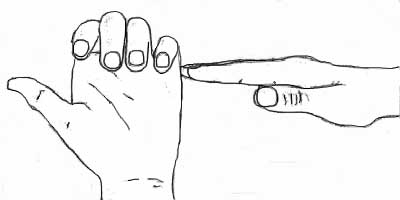
Educational Kinesiology Session according to the program «Brain Gym» and «The program of forming neuro-psychological space of junior schoolchildren»
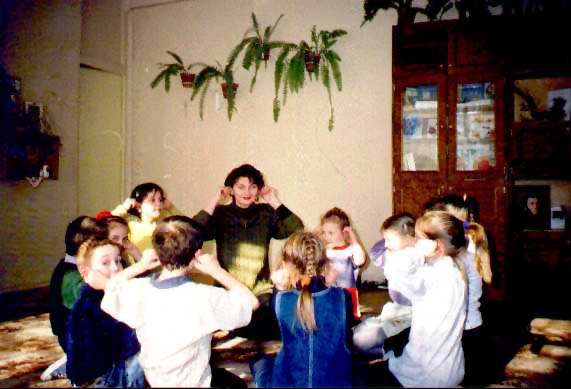
The Thinking Cap. This activity focuses attention on the ears in a positive way. The student uses his thumbs and index fingers to put the ears gently back and unroll them. He begins from the top of the ear and gently massages down and around the curve, ending with the bottom lobe.
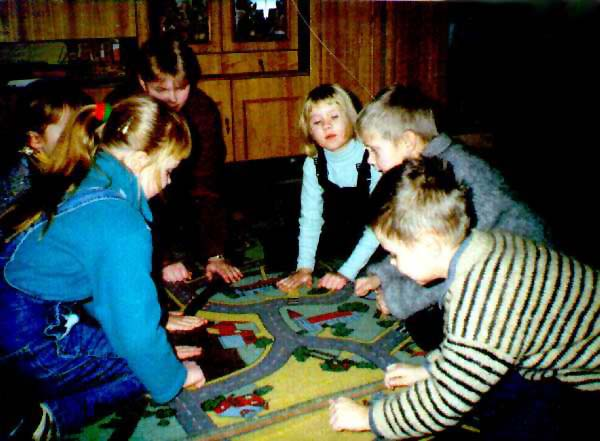
Exercise «The Frog». The pupil puts his hands on the floor or the table. One of his hands is clenched into a fist, the other one is on some plane («the palm»). He changes the position of his hands simultaneously (cross change).
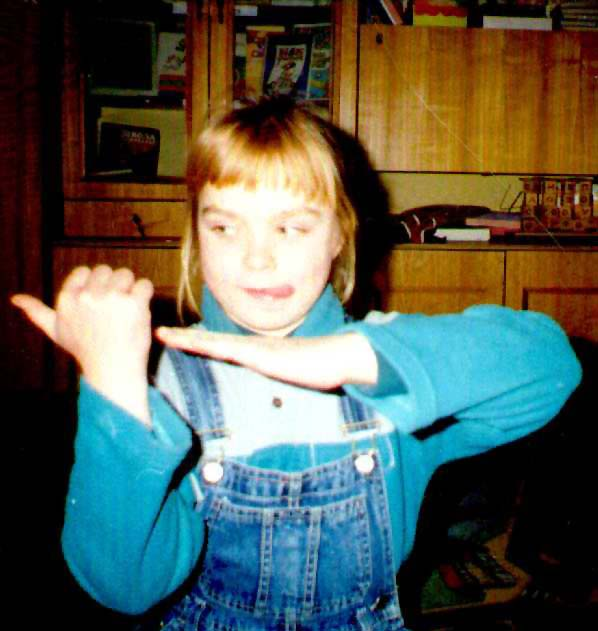
Exercise «Lezghinka» with cross movements of the tongue and eyes.
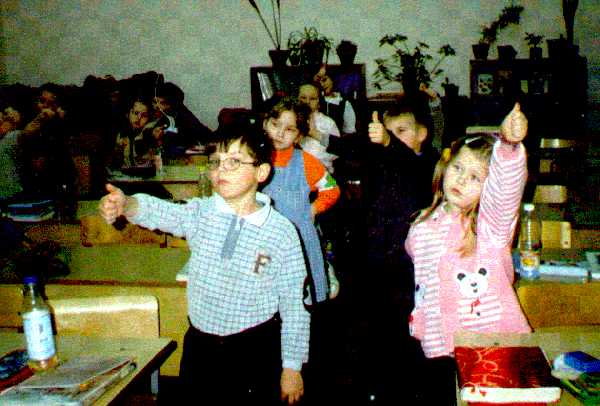
«The Elephant». The pupil leans his head to the shoulder. Then he stretches his hand forward (the elephant’s trunk) and draws horizontal «eight» (a symbol of infinity) with big strokes. Then he does the same exercise with the other hand.
Crawling on the back
Reciprocal walking
References
1. Dennison P., Dennison G. Program «Brain Gym». M., 1997.2. Doman G., Doman D. Preschool education of children. M., 1995.
3. Hannaford K. Wise movement. M., 2000.
4. Luriya A.P. The bases of Neuropsychology. M., 1973.
5. Rotenberg V.S., Bondarenko S.M. Brain, Education, Health. M., 1989.
6. Semenovich A.B. Complex Methods of psycho-motor correction. M., 1998.
7. Shanina G.E. Exercises of special kinesiological complex to restore inter-hemisphere interaction of children and teenagers. M., 1999.
8. Sirotyuk A.L. Correction of Education and development of children. M., 2001.
9. Sirotyuk A.L. Education of children with regard for psycho-physiology. M., 2000.
10. Tsvetkova L.S. Actual Problems of children’s neuro-psychology. M., 2001.
11. Tsvetkova L.S. Methods of neuropsychological diagnostics of children. M., 2000.
12. Usanova O.N. Children with the problems of psychic development. M., 1995.

